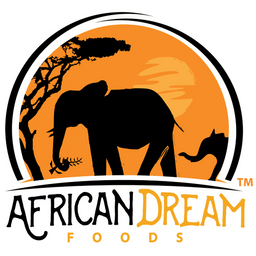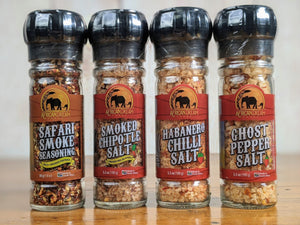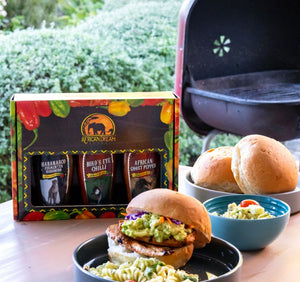What Does BBQ Stand For?
Jun 09, 2022
If you’re a meat lover, you’ve likely chowed down on some BBQ cooking before. However, have you ever stopped to think about the origins of this mouth-watering cooking method? Also, what’s the meaning of BBQ? How did this slang term come to be? And why are there two ways to spell the word in its full form?
In this article, we’ll take a deep dive into the sizzling history of barbecue. Along the way, we’ll try to answer many of your burning (pun intended) questions, including “What does BBQ stand for?” Let’s dig in!
What Does BBQ Stand For?

BBQ is an abbreviation of the word “barbecue.” Depending on what part of the world you’re in, you might also see that BBQ stands for “barbeque,” “barb-cue,” or “bar-b-que.”
Interestingly, tech-savvy folk may understand it to mean “Better Be Quick.” However, they’ll know what you mean if they’re partial to meat and there’s a slab of the stuff sizzling over hot coals nearby.
How Was the BBQ Abbreviation Coined?
There are multiple theories about the origins of the abbreviation.
In a 1982 issue of Tarheel magazine, it’s speculated that the BBQ abbreviation traces its origins to a 19th-century bar. The bar owner coined the term “Bar Beer Cue Pig” to concisely tell prospective customers what to expect. Other bars soon copied this window advertising, and the word morphed into the abbreviation we know and love. So goes this theory.
Another theory speculates that a rancher used a brand with the initials “BQ” while roasting whole sides of beef. As the story goes, a connection between the brand and the cooking method was established, giving rise to “BBQ.”
What’s generally understood is you can trace the earliest use of the abbreviation to the 1930s. However, if you want an in-depth exploration of the abbreviation’s origins, check out this article by Texas Monthly.

Why Are There Two Ways to Spell Barbecue?
You can blame that on the “Q” in the abbreviation. Here’s the thing: “barbeque” and “BBQ” appear to be closer in spelling than “barbecue” and “BBQ.”
Also, it hasn’t helped that food businesses worldwide embraced the former spelling in their BBQ-product-related marketing and branding campaigns. As such, “barbeque” is the more popular spelling.
Which Is Correct: Barbecue or Barbeque?
“Barbecue” is the word’s correct spelling. In fact, the English language describes a barbecue as the indirect cooking of food over an open fire. However, because “barbeque” is so widely used by businesses, people think that’s the correct spelling of the word in its complete form. It isn’t.
Let’s use both spellings interchangeably when referring to this glorious cooking method for brevity.

What Is Barbeque in Cooking?
So, we know what BBQ stands for, but what does it entail exactly? A barbecue involves cooking food over an open fire at low temperatures for extended periods. When we say “food,” meat, fish, and poultry usually come to mind, though it isn’t uncommon to barbecue veggies too.
Occasionally, people also use the term to refer to the apparatus used to cook the food. In this case, barbecuing may refer to using gas, hot coals, charcoal, smoking wood, or other forms of heat.

Commonly, barbecue is used interchangeably with other outdoor cooking methods like grilling. However, it’s a different culinary craft that relies heavily on wood and smoke. We’ll examine each type of outdoor cooking in another section of the article to see how they differ.
Why Is It Called Barbeque?
There are as many theories about the origins of the word “barbecue” as there are foods you can barbecue.
One theory states it originates from the Spanish word “barbacoa.” In that respect, the Spanish explorer Gonzalo Fernández De Oviedo y Valdés gets first-use credit for the word. It first appeared in his journal, which was published in the Diccionario de la Lengua Española (2nd Edition) of the Real Academia Española back in 1526.

Yet another theory suggests the word has French origins. Given how close in spelling “barbecue” is to the French word “Barbe a Queue,” this theory seems plausible. Incidentally, “Barbe a Queue” means “Beard to Tail.” Take that as you will.
However, the most widely accepted theory is the “barbacoa” theory. “Barbacoa” is a word used by a tribe of Caribbean Indians known as the Taino to describe their cooking apparatus. When the Spanish explorers found the Taino cooking meat over a fire, they referred to the cooked meat as “barbacoa.”
Did Slaves Start BBQ?
Kind of. But let’s consider why this is a legitimate question in the first place.
It’s generally agreed that the word “barbecue” traces its sizzling history to the Caribbean. However, today, the practice of barbecuing food is ingrained in American culture. In fact, the southern states of North Carolina, South Carolina, Memphis, and Kansas are credited with evolving the cooking method in that country. Why is that?
In American history, barbecuing can be traced back to colonial times. When migrating European slavers brought Africans to the States, pork and cattle were the primary meat source at the time. However, the poorest cuts of meat had to be cooked slowly and so were reserved for enslaved and low-income people.
As such, in the country’s early days, barbecue was an inexpensive source of food with links to the slave trade. Also, when slavers brought African peoples to the New World, these enslaved people imported their food seasoning practices. (We’ll talk about this more in the section about the history of barbecue sauce below).
So, while enslaved people didn’t invent the American barbecue, you can’t deny their influence on the practice.
Who Invented BBQ?
No one knows. The humble barbecue is a cooking method so ancient that it’s probably been around since early humans discovered cooking with fire. So, if there’s one thing we should be grateful to our ancestors for, it’s their not heeding sound advice about playing with flames.
However, what’s clear is this cooking method arose out of necessity. These days, we take refrigeration for granted. In the past, there weren’t a lot of ways to preserve meat besides drying it, fermenting it, or cooking it quickly.
SEE ALSO: Your Gut Needs Fermented Hot Sauce
What Is the Difference Between a Cookout and a Barbecue?
The main difference is how you cook the food and at what temperature. Let’s look at different outdoor cooking activities to get a better understanding.
Smoking
This outdoor cooking method involves cooking the food for long periods at low temperatures. Standard cooking times range between an hour and two weeks, while temperatures range between 68-176 degrees Fahrenheit.

Smoking can be further broken down into cold smoking (68-86 degrees Fahrenheit) and hot smoking (126-176 degrees Fahrenheit). Cold smoking gives the food a smoky flavor without cooking it, and so it isn’t safe to eat until adequately cooked. Meanwhile, foods that undergo hot smoking are safe to eat due to pasteurizing.
Grilling
Barbecuing is often confused with grilling. However, the two cooking methods can’t be more different. The latter cooking method involves applying high heat over burning coals or gas burners to cook meats like steaks, hot dogs, hamburgers, etc. The former uses indirect heat or hot smoke to simmer the meat.

It’s anyone’s guess why this misconception is so pervasive. However, you can see why when you consider how different cultures refer to cooking utensils and food. For example, in Australia grills are called “Barbies”. Also, when people slather BBQ sauce on chicken before grilling it, they tend to call it BBQ chicken.
While there are many outdoor cooking methods that people call barbecuing, barbecue is different.
Is Barbecued Food Healthy?
Anything consumed without moderation can be potentially unhealthy, and barbecued foods aren’t different. However, science points to barbecued meats posing a severe health risk due to a natural chemical found in meat.
You see, meat contains the organic acid creatine. On its own, creatine helps the muscle cells. The problem arises when you cook meat as it causes a chemical reaction that transforms creatine into Heterocyclic Amines (HCAs). High concentrations of HCAs are a massive no-no because scientific studies have shown that they cause cancer.
So while frying and grilling, meat produces HCAs, and the levels found in barbecues tend to be higher. This is because the heat from barbecues tends to be hotter than that from frying and grilling.
Moreover, fat from barbecued meat tends to drip onto the coals, causing smoke to rise and coat the meat. The smoke contains Polycyclic Aromatic Hydrocarbons (PAHs), which again are known to cause cancer.
However, since most people don’t eat barbecues regularly, the risk posed by cooking meat in this way isn’t very high.
And all of this being said, in terms of weight and calories, BBQ’ing is actually a low-calorie cooking option. Grilling over high heat helps release fat from meat, making it significantly lower in calories compared to frying. When you grill your food, the fat melts and drips off helping reduce your fat intake. Making it great for weight loss.

SEE ALSO: Is Hot Sauce Healthy?
What Foods Can You Barbecue?
The most common meats you’ll find roasting over a barbecue grill are ribs, beef brisket, pork shoulder, chicken, salmon (or other fish), and turkey. In the American state of Kansas, you’ll find even more meats barbecued, including smoked sausage and pulled pork. Meanwhile, it isn’t uncommon in South African braais to have ostrich on the menu.
So, you can barbecue just about anything, including beef, poultry, pork, vegetables, fish, and wild game.

Four Types of American BBQ
Earlier, we mentioned that four American states could be credited with providing the “secret sauce” (if you will) key to evolving the modern-era barbecue. Let’s take a look at the four main styles of American BBQ.

The Carolinas
Barbecue originating from the Carolinas (North and South) are renowned for its slow-roasting pork. Carolina barbecues can be categorized into Eastern-style and Lexington-style. The difference between the two styles is the ingredient list for the sauces used on the pork.
Eastern-style barbecue throws the whole hog over a fire after slathering the pork parts in a mayonnaise-based sauce. Meanwhile, Lexington-style barbecues feature a ketchup and vinegar-based sauce to give a roasted pork shoulder some kick.
Kansas
You’ll be topping your meat with a sauce based on tomatoes and molasses at a Kansas-style barbecue. Speaking of meats, you’ll find a broader range at these barbecues compared to what’s available at Carolina-style ones. Dry-rubbed lamb, pork, and beef find their way onto the plates of attendees after being smoked in a BBQ pit.
Memphis
You’ll find wet and dry-rubbed ribs at a barbecue in Memphis. Usually, hosts slather a sauce on wet-rubbed meat while dry-rubbed meat gets a spice and seasoning rubdown. Then, the cooks barbecue it low and slow to get meat that practically melts off the bone.
Texas (Honorable Mention)
You can’t talk about American-style barbecue without mentioning Texas. In particular, South Texan barbecues feature a cow head cooking on a BBQ pit trailer. Sauces used at such barbecues have a tangy flavor to them.
A Brief History of Barbecue Sauce
Barbecues and barbecue sauce are peas in a pod, so we couldn’t write about BBQ without mentioning the popular condiment.
Like barbecues, the history of the sauces drizzled over the meat goes back to the American colonial era. In 1698, the Dominican missionary Pere Labat observed cooks using lime juice and peppers for seasoning barbecued meat while visiting the French West Indies. The rest, as they say, was history.
If you’re wondering, you can trace the roots of seasoning meat with lime and hot peppers to the African continent. Check out this guide for hot sauce recipes.
Fun Facts About American BBQ:
Here are some fun facts about barbecues as they relate to American culture and history:
- In the colony of Virginia, one of the first laws enacted forbade discharging a firearm at a barbecue.
- Olden-day Americans commemorated the winning of the Revolutionary War with a barbecue.
- Thomas Edison designed the first charcoal briquet factory, which Henry Ford built, in 1921.
- American president George Washington enjoyed barbecues.
What Is a Braai?
Braais are a national barbecue past-time in South Africa that involve large get-togethers. These barbecues are a strictly local wood and charcoal affair, so a braai that uses gas isn’t considered an authentic braai.
The fire is the centerpiece of the braai, and guests gather around it to socialize. The braai’s host picks the wood that stokes the fire, with camel thorn (Kameeldoring) and vinewood (Wingerd) being two of the most commonly used braai wood.
Braais are woven into the DNA of South African culture. They’re used to celebrate events like birthdays, engagements, graduations, and public holidays. If it brings friends and family together, it’s reason enough to get a braai going and have fun.
“Braai” is an Afrikaans word with Dutch origins. It means “to roast,” which is fitting because almost any meat you can think of ends up at a braai. Some of the more exotic meats include ostrich, warthog, and eland!
Braais are usually held on weekends and start around 3 in the afternoon. Please don’t go on an empty stomach, though, as they take a while to get going. So, if you’ve got plans to visit South Africa, add a braai to your food bucket list.
BBQ Styles From Around the World
We’ve established the origins of the word “barbecue” and know that they’re a massive part of American culture. But how do barbecues fare in other parts of the world? Let’s find out!

South Korean Barbecue
Second only to Kimchi, South Korean barbecues are the most famous delicacy in the country. These aren’t the traditional outdoor barbecues; the vast majority happen indoors. Guests get to barbecue their meat and are seated around a grill purpose-built for the occasion.
Chilean Asado
Southern Chile houses 64 percent of the country’s sheep population. So, as you can imagine, that part of the country hosts the most whole-lamb asados. These events feature a parrilero or grill master, and beer and wine flow as freely as meat does.
South African Braai
Braais in South Africa are a national pastime and an excellent way for friends and family to get together. These barbecues feature exotic meats you won’t find anywhere else, making them a genuinely once-in-a-lifetime event if you’re holidaying in the country.
Japanese Yakitori
You could consider Japanese Yakitori a form of urban barbecue as this street food is available widely in major cities. Yakitori is essentially chicken skewered on bamboo and grilled over charcoal.
Filipino Lechon
Filipino-style barbecue features a slow-roasting (sometimes 5 hours). Cooks cram the pig with garlic, lemongrass, fruit, and leeks to season it from the inside. Also, the skin gets rubbed down with coconut water or soy sauce.
To Wrap Up
So, what are the main takeaways from this article? First, the history of barbecues is as fascinating as it is long. Second, “barbecue” – and not “barbeque” – is the correct spelling of the word, and barbecues aren’t the same as grills or other outdoor activities.
The next time you find yourself at a barbecue party, enjoy your meal with a wry smile.




